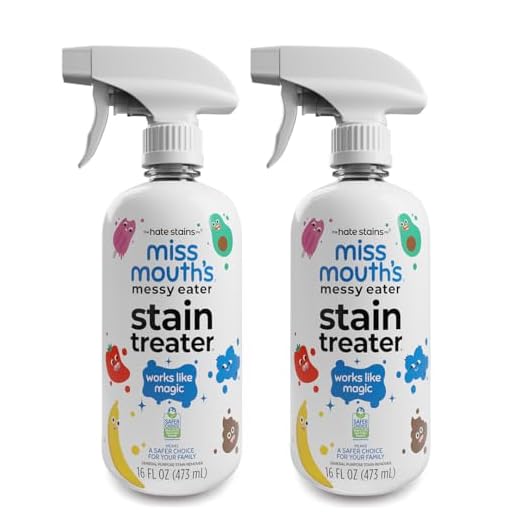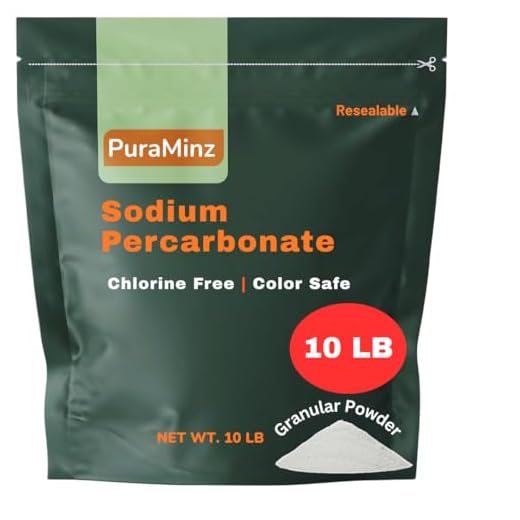



Act swiftly by blotting the affected area with a clean cloth or paper towel to absorb as much liquid as possible. Avoid rubbing, as this can spread the stain further. Next, sprinkle salt or baking soda on the spot to absorb residual liquid and prevent the stain from setting.
Prepare a mixture of cold water and a few drops of dish soap. Using a soft cloth, gently dab the stained area with this solution. Rinse thoroughly with cold water to ensure no soap remains. If the mark persists, consider applying a mixture of hydrogen peroxide and dish soap in equal parts directly to the stain. Allow it to sit for about 30 minutes before rinsing again.
For stubborn discolorations, a commercial stain remover specifically designed for colored materials may be required. Always perform a patch test on an inconspicuous area to ensure the fabric’s dye won’t be affected. Follow the product instructions for the best outcome.
Finally, launder the garment according to the care label instructions. Check the area before drying, as heat can set the stain permanently. If necessary, repeat the cleaning process until the fabric is restored to its original condition.
Removing Stains from Fabric
Immediately blot the stain with a clean, dry cloth to absorb as much liquid as possible. Avoid rubbing, as this can push the liquid deeper into the fibers.
Next, sprinkle salt over the area. Salt acts as an absorbent and can help lift the mark. Let it sit for a few minutes before gently brushing it off.
Combine equal parts of white vinegar and dish soap, then apply the mixture to the affected area. Gently work it into the fabric using your fingers or a soft cloth. Allow it to sit for 30 minutes.
Afterward, rinse with cold water. If the stain persists, create a paste from baking soda and water. Apply the paste directly to the stain and let it dry completely before washing the item as per the care label instructions.
For stubborn marks, consider using a stain remover specifically designed for challenging stains. Always test any cleaning solution on a hidden area first to avoid discoloration.
Lastly, air dry the item instead of using a dryer, as heat can set any remaining stains. Check the fabric after drying; repeat any necessary steps if needed.
Act Quickly: Immediate Steps to Take
Blot the stain with a clean cloth or paper towel, absorbing as much liquid as possible without rubbing. This prevents spreading. Aim for gentle dabbing to lift the excess without pushing it deeper into the fibers.
Sprinkle salt or baking soda over the affected area to absorb the remaining liquid. Let it sit for several minutes before gently brushing it off. This can help in reducing the stain intensity.
Rinse the fabric under cold running water from the back of the stain. This technique pushes the liquid out rather than through the fabric, minimizing damage.
Mix a solution of one part dish soap and two parts hydrogen peroxide. Apply it directly to the stain with a clean cloth, allowing it to sit for about 30 minutes before rinsing thoroughly.
Check the care label before washing. If the item is machine washable, launder it in cold water with an appropriate detergent. Avoid using hot water, as it can set the stain.
If the stain persists after washing, refrain from drying the item. Instead, repeat the soaking and washing process until the stain is completely gone. Applying heat can make it permanent.
Choosing the Right Cleaning Solution for Stains
Opt for a solution containing enzymes, which effectively break down pigments in the fabric. Look for products labeled as stain removers or those specifically designed for tough stains.
Consider natural options like:
- Baking soda: Mix with water to form a paste and apply to the affected area.
- White vinegar: Dilute with water and dab onto the stain, allowing it to sit briefly.
- Lemon juice: Use it as a pre-treatment, especially when combined with sunlight.
Commercial cleaners can also be beneficial. Seek those that are color-safe and suitable for the fabric type. Always perform a patch test on an inconspicuous area before full application.
For persistent marks, try a combination of treatments:
- Apply your chosen cleaner.
- Let it sit for a few minutes.
- Gently blot with a cloth.
- Rinse with cold water.
Repeat as necessary, ensuring to follow the manufacturer’s instructions for the best results. Avoid heat until the stain is completely removed, as this can set the pigment permanently.
Test for Colorfastness Before Treatment
Before applying any cleaning solution, always conduct a colorfastness test on an inconspicuous area of the fabric. Use a cotton swab or a small cloth dampened with the cleaning agent. Dab it gently on the hidden section and observe for any color transfer or fading.
Steps for Testing
1. Choose a hidden area, such as an inside seam or hem.
2. Apply the cleaning solution with a cotton swab.
3. Wait a few minutes, then blot with a white cloth to check for color bleeding.
4. If no color appears on the cloth, proceed with confidence; if there is transfer, reconsider your approach.
Why It Matters
Understanding how the fabric reacts to cleaning agents prevents further damage and ensures that the item remains intact. Protecting the integrity of the garment is as critical as removing the stain itself.
Step-by-Step Guide to Blotting the Stain
Immediately grab a clean cloth or paper towel. Gently blot the affected area, avoiding vigorous rubbing to prevent spreading. Start from the outer edges of the stain and work inward, absorbing as much liquid as possible. Rotate the cloth frequently to use a clean section for optimal absorption.
After blotting, apply a small amount of cold water to the stained area. This helps dilute the pigment. Continue to blot with a fresh cloth until no more color transfers. If needed, consider using a mild detergent mixed with water for additional lifting power.
Final Touches
Once the stain appears lighter, rinse the fabric with cold water. Make sure to check for any residue before proceeding to the next treatment steps. The right tools can make a difference; for example, utilizing the best scrubber for nonstick pans can assist in gently scrubbing the area without damaging the fabric.
Always allow the fabric to air dry away from direct sunlight, as heat can set any remaining stain. If the discoloration persists, repeat the blotting process or seek professional help.
Homemade Remedies for Wine Stains
For tackling those pesky stains, a few kitchen staples work wonders. Here are my go-to solutions:
Baking Soda Paste
- Mix three parts baking soda with one part water to form a paste.
- Apply it generously over the stain and let it sit for 30 minutes.
- Gently scrub with a soft cloth before rinsing with cold water.
Salt Absorbent
- Immediately cover the mark with a generous amount of salt.
- Allow the salt to absorb the liquid for about 5-10 minutes.
- Rinse the area thoroughly with cold water afterward.
White Vinegar and Dish Soap
- Combine one cup of white vinegar with one cup of dish soap.
- Apply this mixture directly onto the stain.
- Let it rest for 15 minutes, then blot with a clean cloth.
These methods can be quite effective, especially when treated promptly. Experiment with these options to find what works best for your fabric.
When to Seek Professional Cleaning Services
Contact a specialist if home remedies fail after several attempts or if the stain remains visible. Additionally, consider professional help for delicate fabrics such as silk or wool, where aggressive treatments may cause damage. If the garment holds significant sentimental or monetary value, entrust it to experts who understand the nuances of fabric care.
Signs Indicating Professional Intervention
Observe the following indicators when deciding to seek expert cleaning services:
| Indicator | Action |
|---|---|
| Stain Persistence | Contact a cleaning service after multiple unsuccessful attempts. |
| Fabric Sensitivity | Consult professionals for delicate materials to avoid damage. |
| Value of Item | Invest in professional care for valuable or cherished garments. |
| Complex Stains | Seek expert advice for stains that are challenging to treat. |
Cost Considerations
Evaluate the cost of professional services against the potential loss of the item. If the expense is justified by the garment’s value or significance, choosing a professional cleaner may be the best option.








